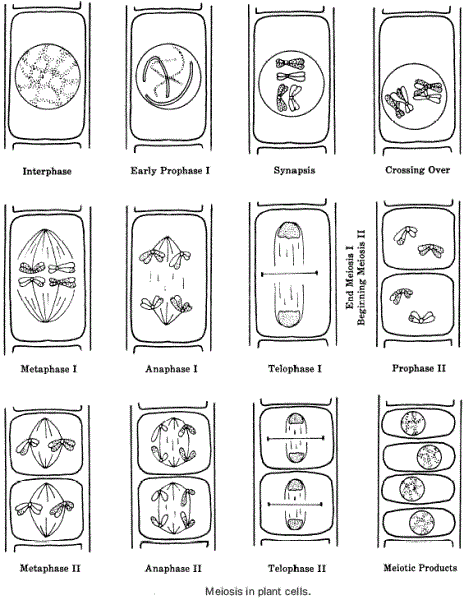Meiosis: Meiotic cell division, stages and significance
- Meiosis is a cell division in which four haploid cells are formed from a single diploid cell.
- It usually occurs in reproductive organs or gonads of the organisms.
- Meiosis is also known as reductional cell division because four daughter cells produced contain half the number of chromosomes than that of their parent cell.
Meiosis has two nuclear division phases:
- Meiosis-I (Reductional or Heterotypic division)
- Meiosis-II (Equational or Homotypic division)
Meiosis-I (heterolytic or Reductional division)
Meiosis-I has four different phases or stages:
- Prophase-I
- Metaphase-I
- Anaphase-I
- Telophase-I
1. Prophase-I
- It occupies the longest duration in Meiosis-I.
- It is divided into five sub-stages or sub-phases.
i. Leptotene
- This phase starts immediately after interphase.
- The size of cell and nucleus increases
- The chromosomes appear long, uncoiled thread-like in structure bearing many bead-like structures called chromomeres.
- The nuclear membrane and nucleolus remain as it is.
ii. Zygotene
- Homologous chromosomes come closer and starts to pair up along their length.
- The pairing of homologous chromosomes is called Synapsis and the paired homologous chromosomes are referred as bivalents.
- The homologous chromosomes are held together by ribonuclear protein between them.
iii. Pachytene
- The chromosome become shorter and thicker.
- Each chromosome of the bivalents splits longitudinally to form two chromatids such that bivalents is composed of four strands and is known as a tetrad.
- The process of crossing over starts (crossing over; a small fragment of chromosome exchange between two non-sister chromatids of bivalent by breakage and rejoining).
- Crossing over is the most important genetic phenomenon of meiosis which causes variation in genetic characters in offspring.
iv. Diplotene
- In this stage crossing over takes place.
- Bivalents (chromatids) repel each other.
- Homologous chromosome (two non-sister chromatids) begins to separates but separation is not complete, they remains attached to a point with a knot like structure called chiasmata (singular – chiasma).
- The number of chiasmata varies. Depending upon the number of chiasmata, chromosome appears different shape.
- 1 chiasmata: cross like
- 2 chiasmata: ring like
- Many chiasmata: series of loop
- Nuclear membrane and nucleolus begins to disappear.
v. Diakinesis
- The chiasma moves towards the end of the chromosomes (tetrad) due to contraction of chromosomelastly slips over separating the homologous chromosome. This movement of the chiasmata towards the end of chromosome is called terminalization.
- By the end of diakinesis the nuclear membrane and nuleolus get completely disappeared and the chromosomes are free in the cytoplasm.
- Spindle fibres begin to form
2. Metaphase-I
- The spindle fibres organized between two poles and get attached to the centromere of chromosomes.
- Chromosome moves to equator
- The bivalent chromosomes are arranged in the equatorial plate in such a way that 2 metaphasic plates are formed.
3. Anaphase-I
- Spindle fibres contracts and pulls the whole chromosomes to the polar region.
- The separated chromosome is known as dyads
- No splitting of chromosomes occurs so the centromere of each homologous chromosome does not divide. Thus, the chromosome number of the daughter nuclei is reduced to half.
- Now the separated chromosome moves toward opposite poles.
4. Telophase-I
- Two groups of chromosome formed at each pole and organized into nuclei.
- The nuclear membrane and nucleolus reappears.
- The chromosomes get uncoiled into chromatin thread.
- The spindle fibres disappear totally.
Cytokinesis I
- Cytokinesis may or may not follow nuclear division (meiosis-I Cytokinesis occurs by cell plate formation method in plant cell and furrowing method in animal cells.
Interphase II or Interkinesis
- The two cells or nuclei thus formed pass through a short stage called interphase-II. Sometimes, interphase-II is absent.
- It is the resting phase between meiosis-I and meiosis-II.
- It is either very short or may be absent
- No DNA synthesis occurs.
Meiosis-II ( Homolytic or equational division)
- Meiosis-II is exactly similar to mitosis, so it is also known as meiotic mitosis.
- In this division, two haploid chromosome splits longitudinally and distributed equally to form 4 haploid cells.
- It completes in 4 stages.
- Prophase-II
- Metaphase-II
- Anaphase-II
- Telophase-II
1. Prophase-II:
- The dyads chromosome becomes thicker and shorter
- Nuclear membrane and nucleolus disappear
- Spindle fibre starts to form
2. Metaphase-II:
- The dyads chromosomes comes to equatorial plane
- Spindle fibres organize between poles and attaches to centromere of chromosome.
3. Anaphase-II:
- Centromere of each chromosome divides and sister chromatids separates to form two daughter chromosome
- Spindle fibre contracts and pull the daughter chromosome apart towards opposite pole.
4. Telophase-II:
- Chromosome become organize at respective pole into nuclei
- Chromosome elongates to form thin networks of chromatin
- Nuclear membrane and nucleolus reappears
Cytokinesis-II:
- The result of cytokinesis is four haploid daughter cells (gametes or spores).
- Cytokinesis takes place by cell plate formation in plant cell
- Successive methods: cytokinesis followed by each nuclear division resulting in 4 haploid cells. Eg. Monocot plants
- Simultaneous methods: cytokinesis occurs only after meiosis-II to form 4 haploid cells. Eg. Dicot plants
- In animal cells, cytokinesis occurs by furrow formation or depression.

SIGNIFICANCE OF MEIOSIS
- Meiosis helps to maintain a constant number of chromosomes by reducing the chromosome number in the gametes
- Essential for sexual reproduction in higher animals and plants
- Meiosis helps in the formation haploid gametes and spores for sexual reproduction.
- Number of chromosome remain fixed in a species from generation to generation
- Crossing over occurring brings genetic variations in offspring which helps in evolution of organisms.
- Failure disjunction in Meiosis leads mutation to the formation of polypoid forms.
- The random distribution of maternal and paternal chromosomes takes place into daughter cells during meiosis and it is a sort of independent assortment which leads to variation.
